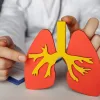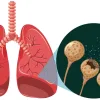Unveiling the Mystery of Lung Disease Diagnosis: A Guide to Understanding the Process
Introduction:
Lung diseases can have a significant impact on an individual’s overall health and quality of life. Early diagnosis and treatment are crucial for managing these conditions effectively. In this article, we will delve into the intricate process of diagnosing lung diseases. We will explore the various methods and tools used by medical professionals to identify these conditions accurately. Whether you are experiencing respiratory symptoms or simply seeking to broaden your knowledge, this comprehensive guide will shed light on how lung diseases are diagnosed.
Part 1: Understanding the Diagnosis Process
- Medical History Evaluation:
- The journey towards diagnosing a lung disease often begins with a thorough evaluation of the patient’s medical history.
- The doctor will inquire about any symptoms experienced, such as coughing, wheezing, shortness of breath, or chest pain.
- They will also assess any risk factors, such as exposure to environmental pollutants, smoking history, or a family history of lung disease.
- This information helps the doctor gain valuable insights into the patient’s condition and aids in formulating further diagnostic strategies.
- Physical Examination:
- Next, a physical examination is conducted to assess the patient’s overall lung health.
- The doctor will listen to the patient’s breathing using a stethoscope to detect abnormal sounds, such as wheezing or crackling.
- They may also examine the patient’s posture, skin color, and overall respiratory effort to gather additional clues about their lung function.
- Lung Function Tests:
- Lung function tests, also known as pulmonary function tests (PFTs), play a crucial role in diagnosing lung diseases.
- These tests measure the capacity and efficiency of the lungs to perform their primary function of oxygen exchange.
- The most common PFTs include spirometry, which assesses lung volumes and airflow, and gas diffusion tests, which measure how well oxygen passes into the bloodstream.
- These tests provide valuable data about lung function and help differentiate between various lung diseases.
- Imaging Techniques:
- Radiographic imaging techniques, such as X-rays and computed tomography (CT) scans, are frequently used to visualize the lungs and identify potential abnormalities.
- X-rays provide a basic view of the lung structures and can help detect conditions like pneumonia, tumors, or fluid accumulation.
- CT scans offer more detailed images, allowing doctors to examine lung tissues, blood vessels, and lymph nodes in greater depth.
- These imaging techniques aid in diagnosing conditions like lung cancer, tuberculosis, or interstitial lung diseases.
- Laboratory Tests:
- Laboratory tests involving the analysis of blood samples and sputum (phlegm) can provide valuable diagnostic information.
- Blood tests may reveal elevated levels of certain biomarkers, indicating inflammation, infection, or autoimmune activity in the lungs.
- Sputum analysis helps identify pathogens, such as bacteria or fungi, which may be causing respiratory symptoms.
Part 2: Fitpaa – Your Partner in Lung Health
If you want to take charge of your lung health and ensure optimal well-being, Fitpaa is here to support you. Our mission is to empower individuals in achieving their health and fitness goals, including managing lung diseases. With our AI-driven technology and personalized approach, we offer a comprehensive solution for monitoring and managing your lung health.
- Personalized Approach:
- Fitpaa leverages the latest advancements in Lifestyle Medicine and Behavioral Therapy to strengthen all 11 organ systems, including the respiratory system.
- Our team of experts, including fitness coaches, nutritionists, and doctors, work together to create a personalized Fitpaa Capsule based on your metabolism, health goals, and lifestyle.
- The Fitpaa Capsule combines medical therapy, exercise therapy, nutrition therapy, and cognitive behavioral therapy to optimize your lung health and overall well-being.
- Real-time Guidance and Monitoring:
- Fitpaa incorporates state-of-the-art technology, such as real-time guidance and metabolism management, to guide you towards your lung health goals.
- Our Fitpaa mobile app acts as your virtual workout trainer, diet tracker, and performance tracker, making it easy to follow your personalized Fitpaa Capsule.
- Fitpaa’s real-time guidance technology ensures timely nudges, habit-building strategies, and purpose-finding techniques from cognitive behavioral therapy, keeping you motivated and inspired throughout your journey.
- Expert Support and Reviews:
- With Fitpaa, you get access to a dedicated team of fitness planners, nutritionists, trainers, and doctors who review your progress regularly.
- They provide unlimited consultations, daily follow-ups, and weekly reviews to ensure you stay on track and make necessary adjustments to achieve your lung health goals.
Conclusion:
Diagnosing lung diseases involves a comprehensive and multidimensional approach. Medical history evaluation, physical examinations, lung function tests, imaging techniques, and laboratory tests all contribute to accurate diagnoses. Fitpaa complements this diagnostic process by offering a personalized and technology-driven solution for managing lung health. With the aim of transforming lives and ensuring well-being, Fitpaa is committed to providing individuals with the tools and support they need to achieve their lung health goals. Take the first step towards optimal lung health by download the Fitpaa app today.









